
Strike Fighter Squadron 86 (VFA-86) is a strike fighter squadron of the United States Navy. It is equipped with the F-35C Lightning II and is stationed at Naval Air Station Lemoore, California. The squadron is nicknamed "Sidewinders", leading to the call sign Winder. The unit is currently assigned to Joint Strike Fighter Wing.

Strike Fighter Squadron 37 (VFA-37), also known as the "Ragin' Bulls", is a United States Navy F/A-18E Super Hornet fighter squadron stationed at Naval Air Station Oceana. They are a part of Carrier Air Wing 8 (CVW-8) and are attached to USS George H. W. Bush. Their radio callsign is Ragin' and their tail code is AJ.
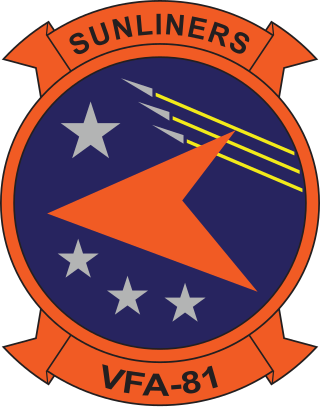
Strike Fighter Squadron 81 (VFA-81), also known as the "Sunliners", is a United States Navy F/A-18E Super Hornet strike fighter squadron stationed at Naval Air Station Oceana. They are currently assigned to Carrier Air Wing 1. Their mission is to conduct prompt and sustained combat operations from the sea. The squadron was originally designated VA-66 on 1 July 1955, was redesignated VF-81 the same day, redesignated VA-81 on 1 July 1959, and finally redesignated VFA-81 on 4 February 1988.

Strike Fighter Squadron 83 (VFA-83), also known as the "Rampagers", are a United States Navy F/A-18E Super Hornet fighter squadron stationed at Naval Air Station Oceana. They are a part of Carrier Air Wing 3, their tailcode is AC and their radio callsign is Ram.

Fighter Squadron Composite 204 (VFC-204), also known as the "River Rattlers", is a United States Navy Reserve adversary squadron, slated to fly the F-5N/F Tiger II after having previously flown the F/A-18C/D Hornet. The squadron is based out of Naval Air Station Joint Reserve Base New Orleans, Louisiana, and is part of the U.S. Navy Reserve's Tactical Support Wing. Their radio callsign is "River" and their tail code is "AF".

VA-106 was an Attack Squadron of the U.S. Navy. Originally established as Bomber-Fighter Squadron Seventeen (VBF-17) on 2 January 1945, it was redesignated Fighter Squadron Six B (VF-6B) on 15 November 1946, redesignated VF-62 on 28 July 1948, redesignated Attack Squadron 106 (VA-106) on 1 July 1955, it was disestablished on 7 November 1969. It was the second US Navy squadron to be designated VA-106.

VA-36, nicknamed the Roadrunners, was an Attack Squadron of the U.S. Navy. It was established as Fighter Squadron VF-102 on 1 May 1952, redesignated VA-36 on 1 July 1955, and disestablished on 1 August 1970. It was the first squadron to be designated VA-36, the second VA-36 was established on 6 March 1987 and disestablished on 1 April 1994.
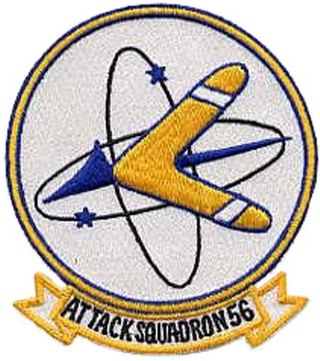
VA-56 was an Attack Squadron of the U.S. Navy. It was established on 4 June 1956, and disestablished thirty years later, on 31 August 1986. The squadron's nickname was the Boomerangs from 1957 to 1958, and the Champions thereafter.
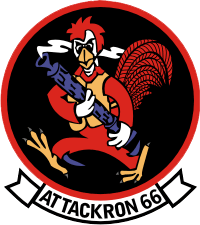
VA-66 was an Attack Squadron of the U.S. Navy; it was the second squadron to be so named. The squadron was called to duty and established as Reserve Fighter Squadron VF-671 on 1 February 1951. It was redesignated Fighter Squadron VF-81 on 4 February 1953, and finally as VA-66 on 1 July 1955. The squadron was disestablished on 1 October 1986, but one detachment continued in existence until 31 March 1987. The squadron's nickname was the Waldomen from the 1950s to the early 1960s, and the Waldos from that point forward. Its insignia, a rooster toting a machine gun, was a well-known design in naval aviation.

Attack Squadron 72 (VA-72) was an aviation unit of the U.S. Navy. It was established as Bomber Fighter Squadron 18 (VBF-18) on 25 January 1945. The squadron was redesignated as Fighter Squadron 8A (VF-8A) on 15 November 1946, as VF-72 on 28 July 1948, and finally as VA-72 on 3 January 1956. It was disestablished on 30 June 1991.

Attack Squadron 85 or VA-85 was a long-lived Attack Squadron of the U.S. Navy. It was called to active duty as U.S. Navy Reserve squadron VA-859 on 1 February 1951 and redesignated VA-85 on 4 February 1953. It was disestablished on 30 September 1994, over 40 years later. The squadron's nickname from 1958-1994 was the Black Falcons. It was the second squadron to be designated VA-85, the first VA-85 was disestablished on 29 November 1949.
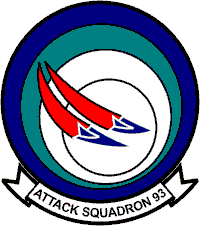
VA-93 was an Attack Squadron of the U.S. Navy. It was established as Fighter Squadron VF-93 on 26 March 1952, and redesignated as VA-93 on 15 September 1956. It was disestablished 30 years later on 31 August 1986. The squadron's nickname was the Blue Blazers from 1954 to 1976 and the Ravens thereafter.

VA-153 was an Attack Squadron of the U.S. Navy. During a 1949 reorganization of the Naval Air Reserve, a Fighter Squadron at NAS New York was redesignated Fighter Squadron VF-831. It was called to active duty on 1 February 1951. The squadron was redesignated as VF-153 on 4 February 1953, and finally as VA-153 on 15 December 1956. It was disestablished on 30 September 1977. The squadron's nickname was the Blue Tail Flies from 1953 onward.

VA-164, nicknamed the Ghostriders, was an Attack Squadron of the U.S. Navy. It was established on 1 September 1960 and disestablished on 12 December 1975.

VA-172 was an Attack Squadron of the U.S. Navy. It was established as Bomber Fighter Squadron VBF-82 on 20 August 1945, redesignated as Fighter Squadron VF-18A on 15 November 1946, as VF-172 on 11 August 1948, and as VA-172 on 1 November 1955. The squadron was disestablished on 15 January 1971. Its nickname was the Checkmates from 1946-1950, and the Blue Bolts thereafter.

VA-216, nicknamed the Black Diamonds, was an Attack Squadron of the US Navy. It was established on 30 March 1955, and disestablished 15 years later on 1 August 1970.

VA-34, nicknamed the Blue Blasters, was an Attack Squadron of the U.S. Navy. The squadron was established as Fighter Squadron VF-20 on 15 October 1943, redesignated as VF-9A on 15 November 1946, as VF-91 on 12 August 1948, and as VF-34 on 15 February 1950. It was finally redesignated VA-34 on 1 July 1955. The squadron was disestablished on 1 June 1969. It was the second squadron to bear the VA-34 designation, the first one having been renamed VA-35 in 1950.
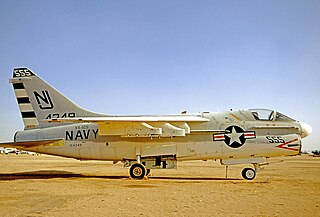
VA-125 was an Attack Squadron of the U.S. Navy, and was the second squadron to bear the VA-125 designation. It was established as VA-26 on 30 June 1956, and redesignated VA-125 on 11 April 1958. The squadron was disestablished on 1 October 1977. Its nickname was Skylanchers from 1956-1958, and Rough Raiders thereafter.

VA-44, nicknamed the Hornets, was an Attack Squadron of the US Navy. The squadron was established as Fighter Squadron VF-44 on 1 September 1950, and redesignated VA-44 on 1 January 1956. It was disestablished on 1 May 1970. It was the second squadron to be designated VA-44, the first VA-44 was disestablished on 8 June 1950.

Attack Squadron 12 (VA-12), also known as the "Flying Ubangis" or "Clinchers", was an attack squadron of the United States Navy active during the Cold War. From their home port at Naval Air Station Cecil Field in Florida, the squadron made more than thirty major overseas deployments aboard aircraft carriers, primarily flying A-4 Skyhawk and later the A-7E Corsair II, including two combat tours in the Vietnam War.

























